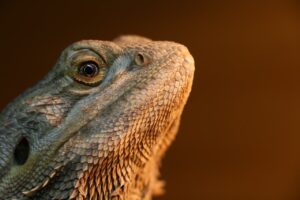All About Bearded Dragons

The bearded dragon, also known as “beardie,” is a popular desert lizard. Their docile and mellow personalities distinguish them from their scaled relatives, and their stunning appearance distinguishes them as genuinely incredible animals.
Central and southern Australia are home to bearded dragons. They are omnivores and have a life expectancy of at least 15 years. This animal communicates its moods to other animals by growing a beard of spines beneath its chin. Because the bearded dragon has cold blood, it must live in warm temperatures. Below are some important facts you should know about bearded dragons.
Appearance of Bearded Dragons
The skin of a bearded dragon is yellowish-tan. It has a long body and a tail over half its length. A bearded dragon can grow up to 2 feet long, including its tail. A bearded dragon can weigh up to 18 ounces as an adult. They have spines under their chins and along their sides. It also has ear holes on each side of its triangular head. A bearded dragon has four strong legs and sharp claws for climbing trees.
A bearded dragon defends itself against predators by changing color and blending into its surroundings. Moreover, its scales and spiny skin protect it from predators such as snakes and hawks. When threatened, this animal puffs up its spiny beard and opens its mouth to appear larger to enemies. Except during mating season, bearded dragons are shy, solitary creatures. They will only become aggressive if their territory is threatened. Males can also be aggressive when selecting a mate.
Reproduction in Bearded Dragons
Bearded dragons lay eggs and are oviparous. They lay 2-14 eggs on average, but some females have been known to lay up to 30.
The bearded dragon breeding season typically runs from September to March, but this can vary depending on the climate. Bearded dragons can be bred in captivity, but they must have a nutritious diet and a secure environment to reproduce successfully. When it’s breeding season, the female will refuse food and become more aggressive.
The breeding season for bearded dragons is usually around 2 months after mating, but it can range between 1-3 months. If the female lays eggs, she will dump them in the sand and leave them to hatch on their own. The eggs will be incubated for 55-60 days.
The baby bearded dragons will be about 3 inches long when the eggs hatch. They are self-sufficient from birth and can fend for themselves. Baby bearded dragons require a lot of hiding places and branches to climb on, as well as a water reservoir.
Behavior of Bearded Dragons
A bearded dragon’s spiny beard helps it communicate in various ways. When this reptile changes the color of its beard and bobs its head quickly, it attempts to assert dominance over another male. When a bearded dragon slowly bobs its head and raises one of its legs, it indicates that it is not a threat to another nearby dragon.
The Health of Bearded Dragons
A bearded pet dragon has a lifespan of 10 to 15 years. When bearded dragons are sick, their backs often turn black, and their legs turn light yellow. Their beards may turn black if they are scared or anxious or if it is mating season.
If you notice that their front teeth are missing, don’t be concerned unless this is accompanied by other concerning signs. The bearded dragon’s teeth can regrow. A beardie, unlike some lizards, cannot regrow its tail.
A Diet of Bearded Dragons
Bearded dragons are omnivores who consume a wide range of foods. They prefer insects but will also consume vegetables, fruits, and other plant materials.
In the wild, bearded dragons primarily consume insects. Mealworms, wax worms, and roaches are among the insects they consume. They will also consume any other insect that crosses their path! In captivity, the most common food for a bearded dragon is crickets. However, wax worms and mealworms can also be fed to them.
Fruits and vegetables are also important for a bearded dragon’s diet. Bearded dragons enjoy a variety of fruits and vegetables, so provide them with a few different options daily. Apples, strawberries, grapes, carrots, sweet potatoes, and broccoli are all good options. Dark, leafy greens like kale can also be fed to them.
The Habitat of Bearded Dragons
There are eight species of bearded dragons found on the Australian continent. They can be found in arid and subtropical environments such as savannas, woodlands, and deserts. Many bearded dragons climb trees and sun themselves on branches. Because they are so high up, they can keep an eye out for predators in the area.
Other bearded dragons bask in the sun on rocks. They can also change their skin color to blend in with the branch they are sitting on. If this reptile spots a predator while sunbathing on a rock, it will scurry into a crack between rocks to hide underground.
Bearded dragons enter a type of hibernation known as brumation when the cold weather season begins in the autumn. This reptile is not fully asleep like a bear while in brumation. The difference is that it does not eat during this time but drinks water to stay hydrated.
Predators and Threats to Bearded Dragons
This reptile can run up to 9 miles per hour, but it is slower than some predators. A bearded dragon’s predators include snakes, birds, dingoes, goannas, and crocodiles. Even an owl may fly down to a branch and catch a sunning bearded dragon. A dingo may also capture a bearded dragon lying on a rock in the afternoon to get some sun.